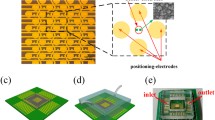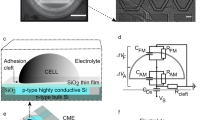Abstract
Nontraumatic, simple, and reproducible procedures for the introduction of nonpermeant molecules into adherent mammalian cells byin situ electroporation are described. Ctells are grown on a glass slide, half of which is coated with electrically conductive, optically transparent, indium-tin oxide. An electric pulse is applied in the presence of the molecules to be introduced, and their effect on the cellular phenotype can be observed. The cells growing on the nonconductive side of the slide do not receive any pulse and serve as controls. Careful adjustment of electric field strength can achieve the introduction of the molecules into essentially 100% of the cells, and this treatment causes no detectable disruption to cellular metabolism. This is applied in the presence of the fluorescent dye, Lucifer yellow, causing its penetration into the cells growing on the conductive half of the slide. The migration of the dye to the nonelectroporated cells growing on the nonconductive area is microscopically observed under fluorescence illumination.
Similar content being viewed by others
References
Potter, H., Weir, L., and Leder, P. (1984) Enhancer-dependent expression of human k immunoglobulin genes introduced into mouse pre-B lymphocytes by electroporation.Proc. Natl. Acad. Sci. USA 81, 7161–7165.
Winegar, R. A., Phillips, J. W., Youngblom, J. H., and Morgan, W. F. (1989) Cell electroporation is a highly efficient method for introducing restriction endonucleases into cells.Mutat. Res. 225, 49–53.
Raptis, L. and Firth, K. L. (1990) Electroporation of adherent cells in situ.DNA Cell Biol. 9, 615–621.
Mir, L. M., Banoun, H., and Paoletti, C. (1988) Introduction of definite amounts of nonpermeant molecules into living cells after electropermeation: Direct access to the cytosol.Exp. Cell Res. 175, 15–25.
Simon, W. C., Raptis, L., Pang, S. C., and Bennett, B. M. (1993) Comparison of liposome fusion and electroporation for the intracellular delivery of nonpermeant molecules to adherent cultured cells.J. Pharm. Toxicol. Meth. 29, 29–35.
Weaver, J. C. (1993) Electroporation: A General phenomenon for manipulating cells and tissues.J. Cell. Biochem. 51, 426–435.
Chang, D. C., Chassy, B. M., Saunders, J. A., and Sowers, A. E. (1992)Guide to Electroporation and Electrofusion, Academic, New York.
Orlowski, S. and Mir, L. M. (1993) Cell electropermeabilization: a new tool for biochemical and pharmacological studies.Biochim. Biophys. Acta 1154, 51–63.
Matsumura, T., Konishi, R., and Nagai, Y. (1982) Culture substrate dependence of mouse fibroblasts survival at 4°C.In Vitro 18, 510–514.
Wade, M. H., Trosko, J. E., and Schindler, M. (1986) A fluorescence photobleaching assay of gap junction-mediated communication between human cells.Science 232, 525–528.
el-Fouly, M. H., Trosko, J. E., and Chang, C. C. (1987) Scrape-loading and dye transfer: A rapid and simple technique to study gap junctional intercellular communication.Exp. Cell Res. 168, 442–430.
McKarns, S. C. and Doolittle, D. J. (1992) Limitations of the scrape-loading/dye transfer technique to quantify inhibition of Gap junctional, Intercellular communication.Cell Biol. Toxicol. 8, 89–103.
Raptis, L., Brownell, H. L., Firth, K. L., and MacKenzie, L. W. (1994) A novel technique for the study of intercellular, junctional communication; electroporation of adherent cells on a partly conductive slide.DNA Cell Biol. 13, 963–975.
Raptis, L. H., Firth, K. L., Brownell, H. L., Todd, A., Simon, W. C., Bennett, B. M., MacKenzie, L. W., and Zannis-Hadjopoulos, M. (1995) Electroporation of adherent cellsin situ for the introduction of nonpermeant molecules, inMethods in Molecular Biology, vol. 48:Animal Cell Electroporation and Electrofusion Protocols (Nickoloff, J. A., ed.), Humana Press, Totowa, NJ, pp. 93–113.
Raptis, L. and Bolen, J.B. (1989) Polyomavirus transforms rat F111 and mouse NIH 3T3 cells by different mechanisms.J. Virol. 63, 753–758.
Raptis, L., Lamfrom, H., and Benjamin, T. L. (1985) Regulation of cellular phenotype and expression of polyomavirus middle T antigen in rat fibroblasts.Mol. Cell. Biol. 5, 2476–2486.
Lu, Y., Raptis, L., Anderson, S., Corbley, M. J., Zhou, Y.-C., Pross, H., and Haliotis, T. (1992) Ras modulates commitment and maturation of 10T1/2 fibroblasts to adipocytes.Biochem. Cell Biol. 70, 1249–1257.
Bahnson, A. B. and Boggs, S. S. (1990) Addition of serum to electroporated cells enhances survival and transfection efficiency.Biochem. Biophys. Res. Commun. 171, 752–757.
Guo, X. B., Ohno, Y., Kawanishi, T., Sunouchi, M., and Takanaka, A. (1992) Indium inhibits gap junctional communication between rat hepatocytes in primary culture.Toxicol. Lett. 60, 99–106.
Chu, G., Hayakawa, H., and Berg, P. (1987) Electroporation for the efficient transfection of mammalian cells with DNA.Nucleic Acids Res. 15, 1311–1326.
Zimmermann, U. (1982) Electric field mediated fusion and related electrical phenomena.Biochim. Biophys. Acta 694, 227–277.
Author information
Authors and Affiliations
Rights and permissions
About this article
Cite this article
Raptis, L.H., Brownell, H.L., Liu, S.K.W. et al. applications of electroporation of adherent cellsIn Situ, on a partly conductive slide. Mol Biotechnol 4, 129–138 (1995). https://doi.org/10.1007/BF02921607
Issue Date:
DOI: https://doi.org/10.1007/BF02921607




